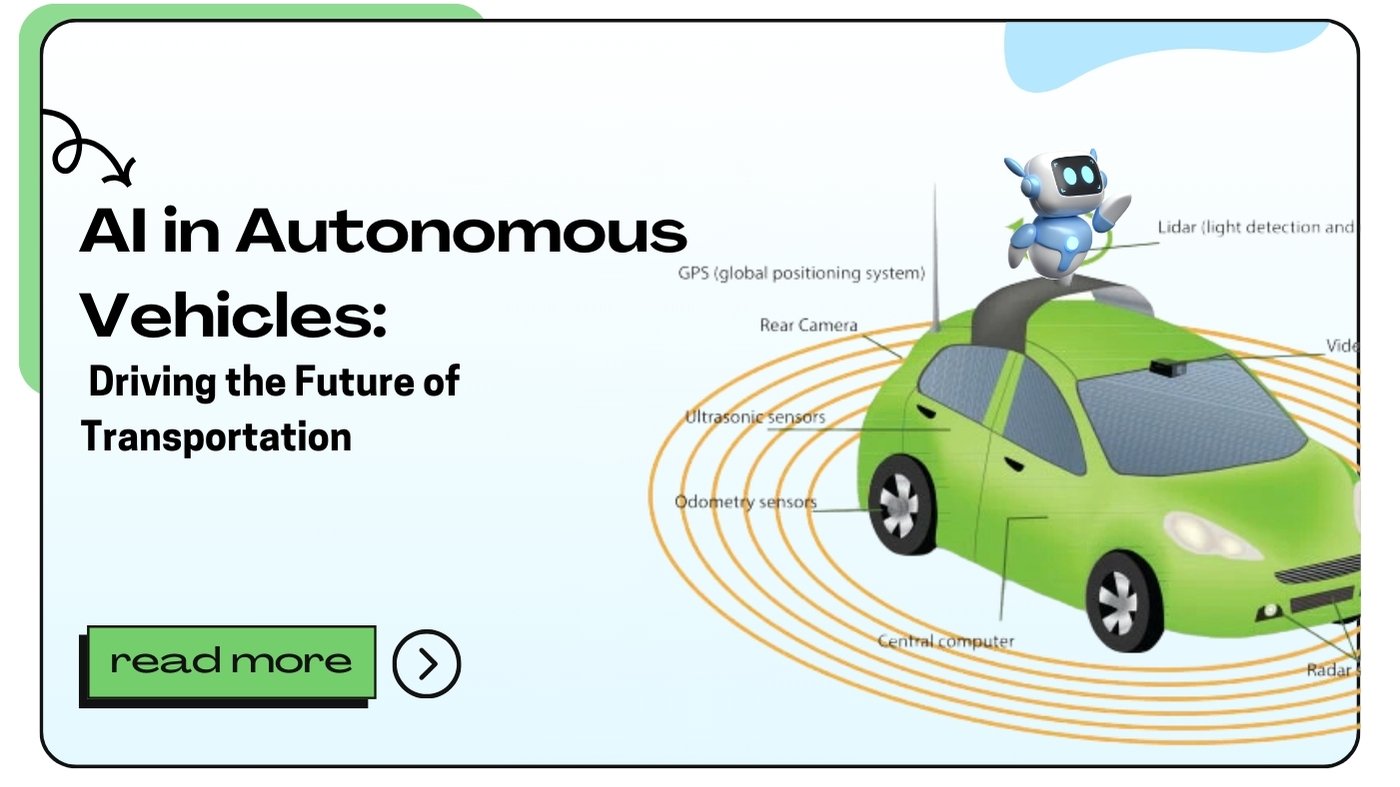The automotive industry is undergoing a transformative change, driven by the advancement of artificial intelligence (AI) in autonomous vehicles. As AI technology evolves, it plays a pivotal role in reshaping how we perceive transportation, promising safer, more efficient, and convenient travel. Autonomous vehicles, commonly known as self-driving cars, are no longer a concept of the future; they are becoming a reality on our roads today.
This comprehensive exploration of AI in autonomous vehicles delves into the technologies involved, the benefits they bring, the challenges they face, and what the future holds for this exciting field. Whether you’re a tech enthusiast, a professional in the automotive industry, or simply curious about the future of transportation, this guide will provide valuable insights into the evolving landscape of autonomous vehicles.
Understanding Autonomous Vehicles
Autonomous vehicles are equipped with advanced technologies that allow them to navigate and operate without human intervention. These vehicles use a combination of sensors, cameras, radar, and AI algorithms to perceive their environment and make informed decisions. The goal of autonomous vehicles is to improve safety, reduce traffic congestion, and enhance mobility.
Levels of Autonomy
The Society of Automotive Engineers (SAE) defines six levels of vehicle automation, ranging from Level 0 (no automation) to Level 5 (full automation):
- Level 0 (No Automation): The human driver is responsible for all tasks.
- Level 1 (Driver Assistance): The vehicle can assist with specific tasks, such as adaptive cruise control.
- Level 2 (Partial Automation): The vehicle can control both steering and acceleration, but the driver must remain engaged.
- Level 3 (Conditional Automation): The vehicle can handle all driving tasks in certain conditions, but the driver must be ready to take control.
- Level 4 (High Automation): The vehicle can operate autonomously in specific environments without driver intervention.
- Level 5 (Full Automation): The vehicle can operate in any environment without human intervention.
The Role of AI in Autonomous Vehicles
Artificial intelligence is at the core of autonomous vehicle technology. It enables vehicles to interpret sensory data, make decisions, and learn from experiences. Here’s a closer look at how AI contributes to the functionality of autonomous vehicles:
1. Perception and Environment Understanding
AI algorithms process data from various sensors to create a comprehensive understanding of the vehicle’s surroundings.
- Sensor Fusion: Autonomous vehicles utilize multiple sensors, including LiDAR, cameras, and radar, to gather information about their environment. AI combines this data to identify obstacles, lane markings, pedestrians, and other vehicles.
- Object Recognition: AI models are trained to recognize and classify objects in real-time, allowing the vehicle to respond appropriately to its surroundings.
2. Decision-Making and Control
AI enables autonomous vehicles to make decisions based on the data they collect.
- Path Planning: AI algorithms determine the optimal route for the vehicle to follow while considering traffic rules, obstacles, and potential hazards.
- Behavior Prediction: AI can predict the behavior of other road users, such as the likelihood of a pedestrian crossing the street or a car changing lanes.
3. Machine Learning and Adaptability
Machine learning techniques allow autonomous vehicles to improve their performance over time.
- Training on Data: Autonomous vehicles are trained on vast datasets that include various driving scenarios, weather conditions, and road types. This training helps the vehicle learn how to navigate complex situations.
- Continuous Learning: AI systems can adapt to new environments and situations by learning from real-world experiences, enhancing their decision-making capabilities.
Benefits of AI in Autonomous Vehicles
The integration of AI in autonomous vehicles brings numerous advantages, revolutionizing the way we travel. Here are some key benefits:
1. Enhanced Safety
One of the primary goals of autonomous vehicles is to improve safety on the roads.
- Reduced Human Error: A significant percentage of traffic accidents result from human error, such as distracted driving or poor decision-making. Autonomous vehicles can reduce these risks by relying on AI-driven decision-making.
- Advanced Safety Features: Autonomous vehicles are equipped with advanced safety features, such as emergency braking, collision avoidance, and lane-keeping assistance, which contribute to safer driving.
2. Increased Efficiency
AI technologies enhance the efficiency of transportation systems.
- Optimized Traffic Flow: Autonomous vehicles can communicate with each other and traffic management systems to optimize traffic flow, reducing congestion and travel times.
- Fuel Efficiency: AI can optimize driving patterns, leading to better fuel efficiency and lower emissions.
3. Greater Accessibility
Autonomous vehicles have the potential to improve mobility for individuals with disabilities or those unable to drive.
- Expanded Transportation Options: Self-driving cars can provide transportation solutions for people who cannot drive due to age, disability, or other factors, enhancing their independence.
- Public Transportation Integration: Autonomous shuttles and buses can supplement public transportation systems, making them more accessible and efficient.
Challenges and Considerations
While AI in autonomous vehicles offers numerous benefits, it also presents challenges that need to be addressed. Understanding these challenges is crucial for the successful implementation of autonomous technology.
1. Regulatory and Legal Issues
The development and deployment of autonomous vehicles raise regulatory and legal questions.
- Liability and Insurance: Determining liability in the event of an accident involving an autonomous vehicle is a complex issue that requires careful consideration.
- Regulatory Framework: Governments need to establish regulations governing the testing and deployment of autonomous vehicles to ensure public safety.
2. Technical Limitations
Despite advancements in AI, there are still technical challenges to overcome.
- Sensor Limitations: While sensors provide valuable data, they can be affected by adverse weather conditions, such as heavy rain or fog, which may impact the vehicle’s ability to perceive its environment accurately.
- Complex Environments: Urban environments with pedestrians, cyclists, and other vehicles present complex challenges for autonomous navigation.
3. Public Acceptance and Trust
Gaining public trust in autonomous vehicles is crucial for their widespread adoption.
- Perception of Safety: Many individuals remain skeptical about the safety of self-driving cars. Building confidence through successful testing and transparent communication is essential.
- Education and Awareness: Public education campaigns can help inform individuals about the benefits and safety features of autonomous vehicles.
The Future of AI in Autonomous Vehicles
The future of AI in autonomous vehicles is promising, with ongoing research and development shaping the industry. Here are some trends to watch:
1. Advancements in AI Technology
As AI technology continues to evolve, we can expect significant advancements that will enhance the capabilities of autonomous vehicles.
- Improved Algorithms: Ongoing research will lead to more sophisticated algorithms capable of handling complex driving scenarios.
- Integration of AI with Other Technologies: The combination of AI with technologies like 5G and edge computing will enable real-time data processing and improved communication between vehicles and infrastructure.
2. Wider Adoption of Autonomous Vehicles
As technology matures and regulatory frameworks are established, we can expect a gradual increase in the adoption of autonomous vehicles.
- Pilot Programs: Many cities and companies are already launching pilot programs for autonomous shuttles and taxis, paving the way for broader acceptance.
- Partnerships and Collaborations: Collaborations between automakers, tech companies, and government agencies will accelerate the development and deployment of autonomous vehicles.
3. Impact on Urban Mobility
The rise of autonomous vehicles will reshape urban mobility and transportation infrastructure.
- Smart Cities: Autonomous vehicles will play a crucial role in the development of smart cities, integrating with other transportation systems to create efficient urban environments.
- New Mobility Services: The emergence of autonomous ride-sharing services will change the way people access transportation, potentially reducing car ownership rates.
Conclusion
AI in autonomous vehicles is driving the future of transportation, promising safer, more efficient, and accessible travel options. As technology continues to advance, the integration of AI will enhance the capabilities of autonomous vehicles, transforming how we move and interact with our environment.
While challenges remain, the potential benefits of autonomous vehicles are significant, offering solutions to some of the most pressing issues in transportation today. By embracing these innovations and addressing the challenges head-on, we can pave the way for a new era of mobility that enhances the quality of life for individuals and communities alike.
20 Unique FAQs About AI in Autonomous Vehicles
- What are autonomous vehicles?
Autonomous vehicles are self-driving cars equipped with technology that allows them to navigate without human intervention. - How does AI contribute to autonomous vehicles?
AI processes sensory data, makes decisions, and enables learning from experiences, enhancing vehicle performance and safety. - What are the levels of vehicle autonomy?
The SAE defines six levels of autonomy, from Level 0 (no automation) to Level 5 (full automation). - What sensors do autonomous vehicles use?
Autonomous vehicles use sensors like LiDAR, cameras, and radar to perceive their surroundings. - How do autonomous vehicles improve safety?
By reducing human error and utilizing advanced safety features, autonomous vehicles can significantly enhance road safety. - What are the benefits of autonomous vehicles for the environment?
Autonomous vehicles can optimize driving patterns, reduce emissions, and improve fuel efficiency, contributing to environmental sustainability. - What challenges do autonomous vehicles face?
Challenges include regulatory issues, technical limitations, and public acceptance. - How can autonomous vehicles improve accessibility?
They can provide transportation solutions for individuals unable to drive, enhancing mobility for those with disabilities or elderly individuals. - What role do regulations play in autonomous vehicle deployment?
Regulations establish safety standards and guidelines for testing and deploying autonomous vehicles on public roads. - How do AI algorithms help with decision-making in autonomous vehicles?
AI algorithms analyze sensory data to make real-time decisions regarding navigation, speed, and obstacle avoidance. - What is the impact of weather on autonomous vehicle performance?
Adverse weather conditions, like heavy rain or snow, can affect the performance of sensors, challenging the vehicle’s navigation capabilities. - How are public perceptions of autonomous vehicles changing?
Public perception is gradually shifting as successful testing and education efforts increase awareness and trust in autonomous technology. - What is the future of urban mobility with autonomous vehicles?
Autonomous vehicles will reshape urban mobility by integrating with smart city infrastructure and providing new transportation services. - How can autonomous vehicles contribute to smart cities?
Autonomous vehicles can integrate with traffic management systems and other smart technologies to enhance urban transportation efficiency. - What partnerships are driving advancements in autonomous vehicles?
Collaborations between automakers, technology companies, and government agencies are key to developing and deploying autonomous vehicles. - How does machine learning enhance autonomous vehicle performance?
Machine learning allows vehicles to learn from vast datasets, improving their decision-making capabilities and adaptability. - What is the significance of sensor fusion in autonomous vehicles?
Sensor fusion combines data from multiple sensors to create a comprehensive understanding of the vehicle’s environment, enhancing safety and navigation. - How will autonomous vehicles affect traffic congestion?
By optimizing traffic flow and reducing accidents, autonomous vehicles have the potential to decrease traffic congestion in urban areas. - What role does public education play in autonomous vehicle adoption?
Public education helps inform individuals about the benefits and safety features of autonomous vehicles, building trust and acceptance. - When can we expect widespread adoption of autonomous vehicles?
Widespread adoption will depend on continued advancements in technology, regulatory frameworks, and public acceptance, likely occurring in the next decade.
- Natural Language Processing (NLP): How AI Understands Human Language - October 4, 2024
- AI in Autonomous Vehicles: Driving the Future of Transportation - October 4, 2024
- The Role of AI and Automation in NetSuite: Enhancing Business Efficiency - October 4, 2024




















